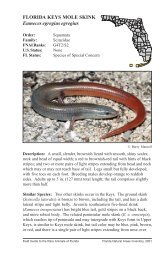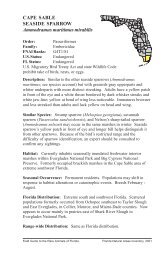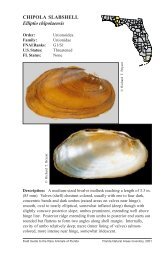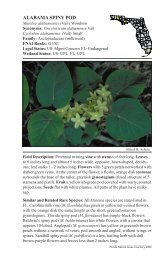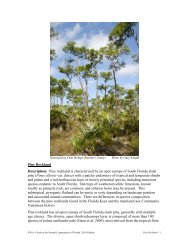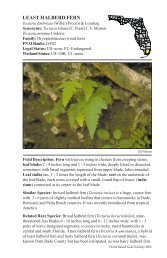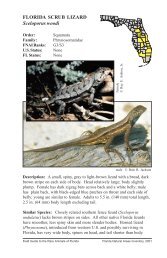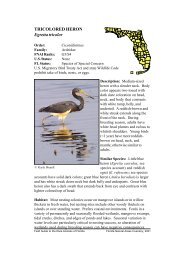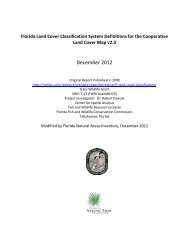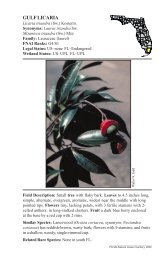Asclepias viridula - Florida Natural Areas Inventory
Asclepias viridula - Florida Natural Areas Inventory
Asclepias viridula - Florida Natural Areas Inventory
Create successful ePaper yourself
Turn your PDF publications into a flip-book with our unique Google optimized e-Paper software.
SOUTHERN MILKWEED<br />
<strong>Asclepias</strong> <strong>viridula</strong> Chapm.<br />
Synonyms: none<br />
Family: Asclepiadaceae (milkweed)<br />
FNAI Ranks: G2/S2<br />
Legal Status: US–none FL–Threatened<br />
Wetland Status: US–FACW- FL–FACW<br />
FNAI<br />
Field Description: Perennial herb from a thickened rootstock. Stems erect,<br />
slender, purplish at base, smooth except for a line of small hairs between leaf<br />
nodes. Leaves 2 - 4 inches long, smooth, opposite, very narrow, slightly<br />
widened near tip, 10 - 20 pairs per stem. Flowers 6 - 10, in flat-topped clusters<br />
on stalks in the angle between upper leaves and stem; pale green with<br />
maroon tint; petals curved sharply downward; corona consists of incurving<br />
horns and erect, unlobed hoods that cover the stigma. Fruit an elongated<br />
pod, erect, smooth, up to 4 inches long. All parts of the plant with milky sap.<br />
Similar Species: Carolina milkweed (<strong>Asclepias</strong> cinerea) lacks the line of<br />
stem hairs; it has lavender flowers with lobed hoods shorter than and not<br />
covering the stigma. Michaux’s milkweed (<strong>Asclepias</strong> michauxii) has hairy<br />
stems; pale green flowers in a cluster on main or side branches with hoods<br />
covering the stigma but no horns; leaves are alternate or subopposite.<br />
Related Rare Species: Curtiss’ milkweed (<strong>Asclepias</strong> curtissii), stateendangered,<br />
is found in scrub and sandhill in central peninsular FL.<br />
_______________________________<br />
<strong>Florida</strong> <strong>Natural</strong> <strong>Areas</strong> <strong>Inventory</strong>, 2000
Southern milkweed<br />
<strong>Asclepias</strong> <strong>viridula</strong><br />
Habitat: Wet flatwoods and prairies, seepage slopes, pitcherplant bogs.<br />
Best Survey Season: Flowers April–July following fire, otherwise very<br />
difficult to see.<br />
Range-wide Distribution: Endemic to FL Panhandle and NE FL.<br />
Conservation Status: Southern milkweed was once more widespread in<br />
northern FL, but is now mainly found in the Apalachicola National Forest,<br />
where about 30 populations are protected.<br />
Protection & Management: Avoid disruptions to<br />
soil and hydrology, such as bedding, chopping, and<br />
pine planting. Burn every 2 - 3 years.<br />
References: Clewell 1985, Coile 1999, Coile 2000,<br />
Godfrey and Wooten 1981, Wunderlin 1998,<br />
Wunderlin and Hansen 2000a.<br />
hood<br />
horn<br />
flowers in bud<br />
petals<br />
pod<br />
line of hairs<br />
on stem<br />
_______________________________<br />
<strong>Florida</strong> <strong>Natural</strong> <strong>Areas</strong> <strong>Inventory</strong>, 2000




